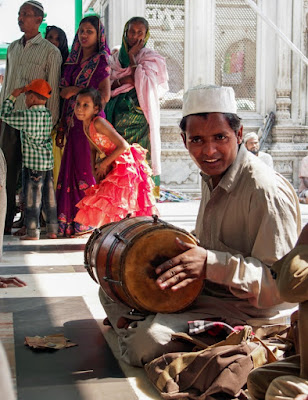 |
| Flower power... |
The burial place of a venerated Sufi saint.
Why visit?
Nizamuddin Dargah is certainly not a minor sight to many of India's muslims. The saint, who died almost 700 years ago, still receives lots of visitors.
This shrine portrays a version of Islam that is very different from the one we see all too often in the media. Being a Sufi, Nizzamuddin was the muslim version of a hippie: peace, love and psychedelic music, all to achieve universal happiness.
India's Islamic heritage is most prominent in its signs of Mughal power: forts, palaces, and oversized tombs. But here you will find a less domineering, and more intimate and spiritual version of Indian Islam.
Where?
In Delhi, in Nizamuddin West (the neighbourhood was named for the saint). Map.
IF YOU'VE ever seen whirling dervishes you will have seen Sufis in action. Sufism is the mystical form of Islam. Nizamuddin Auliya was born in the 13th century and over time has become India's most important Sufi saint. He was buried in a dargah (a shrine built over a saint's grave) that bears his name: Nizamuddin Dargah.
I first came across Nizamuddin Dargah in William Dalrymple's classic book on Delhi, City of Djinns, which explores the fascinating multi-layered, multi-faceted capital. According to Dalrymple, Nizamuddin, while alive,
'promised his followers that if they loosened their ties with the world, they could move towards direct experience of God. Rituals and fasting were for the pious, said the saint, but love was everywhere and was much the surest route to the divine.'I think Nizamuddin would have felt right at home in late '60's San Francisco. So here we are, 700 years later, and while the Mughals have gone, and their palaces are now strictly for tourists, the shrine of this poor hippie saint still attracts a steady stream of pilgrims, for whom the saint is still an active presence- answering their prayers, listening to their quiet cries for support, and providing spiritual solace- and psychedelic music.
If you can, come on a Thursday evening, you can join the faithful in weekly qawwali performances, when the faithful trip on trance-inducing Sufi songs, aiming to achieve spiritual ecstasy. Peace out man...
 |
| Peace, Love and Music. |
 |
| Don't forget to buy a souvenir. |
Getting there:
Nizamuddin Dargah is close to the Nizamuddin train station, but most often the easiest way to get here is to take an auto-rickshaw. The lanes close to the shrine are narrow and crowded- be prepared to walk the last few hundred meters. Dress respectfully and people will treat you with respect in return.
Useful links:
Dalrymple in The Guardian on Sufism.
William Dalrymple's documentary on Sufism, Sufi Soul, is available on YouTube.





There's also a historic and interesting baoli / stepwell just before the Dargah (now used by boys as a swimming pool when the weather is hot)
ReplyDeletePhilip, hi, yes that's true. I just don't have any good pictures of it. There's a legend that the Delhi Sultan rounded up the workers on Nizamuddin's well to build his own well at Tughlaqabad. Nizamuddin put a curse on it and 7 centuries later, the Sufi's well s still there while Tughlaqabad is a ruin... or something to that effect.
Delete